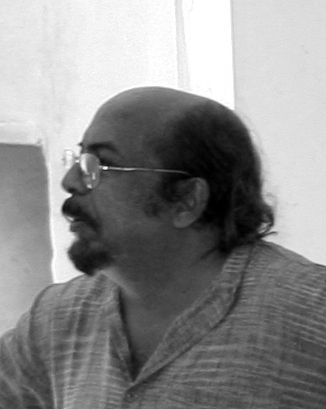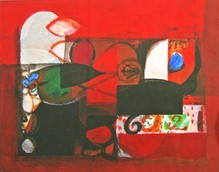
-
From 22 Feb-2022 To 27 Feb-2022
-
From 14 Jul-2023 To 23 Jul-2023
Attained a Diploma in Painting from the Government College of Arts & Crafts, Chennai, in 1970; became a member of the Cholamandal Artists Village in 1966
†
Selected Exhibitions
New Work by P. Gopinath, Solo Exhibition, The Noble Sage, London (2011); 'The Metaphor and Beyond', Gallerie 88, Kolkata (2010); Chennai Excite, The Noble Sage, London (2006); Expressions: The Art Within: an exhibition of paintings by contemporary artists, Kasthuri Srinivasan Art Gallery, Coimbatoire, India (2005); Contemporary Artists of South India, Kuhu's Gallery, London (2005); Beyond the Horizon exhibition by senior artists of Tamil Nadu, Gnani Arts, Singapore (2003); A Contemporary Vision, Lalit Kala Akademi Regional Centre, Chennai (2004); 36 Years of the Cholamandal Artists Village Exhibition, Cholamandal Artists Village, Chennai (2000); Lalit Kala Akademi Group Show, Gallery Art Centrum, Boda, Glasburk, Sweden(1999);Symbolism and Geometry in Indian Art , National Gallery of Modern Art, New Delhi (1998); Movements in Indian Art A Tribute, All India Exhibition, Chithra Kala, Parishad, Bangalore (1998);Major Trends in Indian Art since 1947, Lalit Kala Akademi in New Delhi, Chennai, Mumbai and Calcutta (1997);100 Years National Gallery of Modern Art, All India Exhibition, National Gallery of Modern Art, New Delhi; Art for Hearts Sake, Sothebys Auction, Mumbai(1994); Indiase Moderne Kunst, Kasteel, Arcen, Holland (1989); VIII Biennel International de Art, Valparaiso, Chile (1987); Indian Council for Cultural Relations Exhibition, Morocco (1985); Asia and Pacific Museum, Poland (1985); Art Trends in the Southern Region, Chennai (1981); IV International Triennale India, New Delhi (1978); Pictorial Space, All India exhibition, Lalit Kala Akademi, New Delhi (1977)
†
Selected Awards
Tamil Nadu State Akademi Annual Exhibition Jury member (2000); Represented India as Commissioner for the International Festival of Painting, France (1990);Nominated as Eminent Artist Member by Lalit Kala Akademi, New Delhi (1988); State Award from Lalit Kala Akademi, Chennai (1980)
†
Selected Collections
National Gallery of Modern Art, New Delhi; Lalit Kala Akademi, New Delhi; Kerala Government Museum; Lalit Kala Akademi, Chennai; Lalit Kala Akademi, Kerala
†
Selected Bibliography
Structure, Order and Vision: Paintings of P. Gopinath, article by Shivaji K. Panikkar, 2002; Cholamandal: An Artists Village, edited by Josef James, Oxford University Press, 2004; Southern Axis A Selection of Contemporary Art of Southern India, edited by Meena Dadha, Mukti, 2005
I rely on intuitionI don't like a static finality in my work, a certain feel of the unfinished can be good sometimes.
Known for his biomorphic abstract shapes and warm red and orange palette, Gopinath is a key proponent of the late Madras Movement and certainly one of the most talented semi-abstract painters in South Indian contemporary art today. Gopinaths first recollections of art are his memories of watching his grandfather creating giant charcoal and chalk drawings and the ritualistic kolams drawn as part of Hindu ceremony. Unlike in other families, his young talent and fascination with art did not go unheeded. No less than artist K.C.S. Panniker, Gopinaths uncle, encouraged art as a career path for the young Gopinath. Soon he joined the Government College of Arts & Crafts and was receiving honours such as the State Award whilst he was still only in his second year. Indeed it was Pannikers early watercolours that most influenced Gopinaths initial work, that and Pannikers strong nativist beliefs for the future of Indian art. Gopinath began exploring ideas and forms that related specifically to his Indian context for example, images of the mother archetype, ancient Hindu symbology, the phallic linga forms, as well as a variety of traditional and religious literary and visual sources. However by the late 1960s Gopinaths art was finding a new pictorial language of his own based on principles of architectural versus pictorial space, and inspired largely by Madhubani paintings and Pahadi miniatures. Using these art forms as a springboard, Gopinath began to investigate how such definitively explained pictorial space could be reconstructed through largely flat colour, tone, sensation and the clever organisation of shapes, motifs and biomorphic forms on the two-dimensional surface of the canvas. The visual structure of Persian miniatures and classical Indian paintings became reduced in Gopinaths art to working forms that resonated architecturality: arches, covings, angles, corners, receding shapes and foreground obstacles. Today this organisation of pictorial elements in order to give a sense of three-dimensional space or events is still a challenge welcomed by the artist. Although the painter maintains that all things in his paintings come by chance rather than by will, it is clear to see in all his works that they share a need to inform the viewer of a sense of place and, in many ways, bestow a feeling of comfort. We feel something recognisable in all Gopinaths works for this reason; as arrangements of shapes and abstract forms go, these groupings are mysteriously welcoming.
†
The Noble Sage has acquired eight small works by Gopinath. These sketchbook works, rather than being secondary studies for larger pieces, are of equal importance to his large canvases. Gopinath professes that it is in this smaller format that he tackles the larger abstract compositional problems of spatial organisation and colour harmony. Gopinath has been creating these abstract documentary paintings in his sketchbooks since his early student days when he began to formulate his own concepts and ideas for his art and thus they have a historical, nostalgic value for the artist. Of course their spatial structure summons up the Indian miniatures that have had a long-term appeal to Gopinath, but they are also reminiscent of India today. We see shapes and colours that transform in front of our eyes into street-side monuments, temple paraphernalia, elegant archways, graffiti on walls, ornate carpets and colourful draped garments. He cleverly layers these metamorphosing shapes keeping a constant eye on the overall effect. Gopinath is aware that the effect of these smaller works is different to his large canvases: the colours here swamp the eye with sensation, often filling the viewer with their warm, welcoming hues. This he puts down to the dimensions of the work being well within the visual perimeter of very close inspection by the viewer. As we are so close to the work, it becomes something all engulfing and the decorative aspect of shapes is perhaps lessened.








